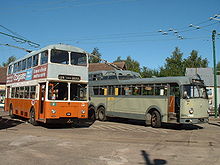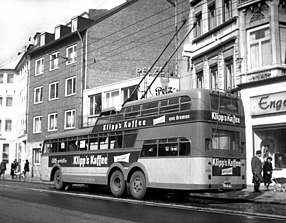Aachen trolleybus
| Aachen trolleybus | |
|---|---|
| One and a half decker 22 in 1962 | |
| Basic information | |
| Country | Germany |
| city |
Aachen Baesweiler |
| opening | January 2, 1944 |
| Shutdown | 3rd February 1974 |
| operator | ASEAG |
| Infrastructure | |
| Depots | 1 |
| business | |
| Lines | 1 |
| The trolleybus line is shown in dashed lines on this map of the Aachen tram network (as of 1960) | |
The trolleybus Aachen was the trolleybus system in the city of Aachen . It operated from 1944 to 1974 and was operated by the Aachener Straßenbahn und Energieversorgungs-AG (ASEAG). The only trolleybus route led from Kaiserplatz to Baesweiler and supplemented the Aachen tram .
history
After plans by the Aachener Kleinbahn-Gesellschaft (AKG) for the construction of an express tram from Aachen to Alsdorf had failed due to the Great Depression in 1930, a power post line of the Reichspost was initially set up between Aachen and Alsdorf .
During the Second World War , the AKG successor company ASEAG managed to start building a trolleybus line on the connection between Hansemannplatz and Baesweiler from 1942. On January 2, 1944, this line 31 was finally put into operation, with 19.1 kilometers it was one of the longest trolleybus lines in Germany. As early as September 13th, the overhead line had to be dismantled and operations stopped by order of the Wehrmacht .
From 1946, ASEAG temporarily used diesel buses on route 31. Reconstruction of the overhead line could only begin in 1948. On November 21, operation began with trolleybuses between Alsdorf and Baesweiler. The current line 51 was extended on February 28, 1949 to Würselen and on May 15, 1949 finally to Hansemannplatz. There, on June 15, the house block loop was opened via Ottostraße to Kaiserplatz and back via Heinrichsallee. In Aachen, a short branch line to the tournament site of the CHIO Aachen was built. There were intermediate turning loops in Alsdorf and Würselen, while in Baesweiler a larger block loop was created up to the final stop at the Carl Alexander mine . A depot access led to the tram depot on Talstrasse, where the trolleybuses were also stationed. There was also a small car hall for two vehicles at the terminus in Baesweiler.
Further expansion plans were not implemented. Several times, most recently in 1968, the ASEAG adapted the overhead contact line to changed road layouts, especially in Aachen and Alsdorf. Since the power supply of the trolleybus was linked to that of the tram network, line 51 was converted to diesel-powered articulated buses a few months before the last tram line was closed on February 3, 1974.
vehicles

When operations began in 1944, eight brand-new two-axle vehicles and five trailers were initially available. Four cars each came from MAN / Kässbohrer and four from Henschel / Schumann; SSW supplied the electrical equipment. The fleet was soon supplemented by four cars requisitioned in Antwerp , which had to be returned after the end of the war.
From 1948 the first four trolleybuses could be put back into operation, soon supplemented by further deliveries. In 1950 there were already 13 vehicles, plus six trailers. During the horse show, ASEAG also borrowed additional trolleybuses from other companies. In 1952 five copies of the standard type ÜHIIIs were delivered by Henschel, they had the road numbers 14 to 18. 1955 followed three more Henschel cars, this time of the type 562 E. In 1957 the ASEAG procured a one -and- a -half-decker OB bus that has been in the English Trolleybus Museum since 1972 Sandtoft stands. In 1962 ASEAG was also able to acquire another five ÜHIIIs from the closed trolleybus operation in Gummersbach .
In 1968 ASEAG bought a total of 13 articulated cars of the type HS 160 from the years 1957 to 1961 from the Bielefeld trolleybus and the Siegen trolleybus . All older two-axle cars could then be retired, and the line was converted to one-man operation. After it was discontinued, three articulated trolleybuses each could be sold to the Kaiserslautern trolleybus and the Kapfenberg trolleybus in 1974 , the rest was scrapped.
literature
- Reiner Bimmermann: Aachen tram. Volume 1: History . Schweers + Wall, Aachen 1999, ISBN 3-89494-116-2
- Marcel Cremer-Chapé: ASEAG - 50 years of energy supply, 70 years of trams - A look at the past and present, Aachen 1950 (ASEAG commemorative publication)
- Werner Stock: Trolleybus systems in Germany . Hermann Busch Verlag, Bielefeld, 1987
Web links
Individual evidence
- ^ Werner Stock: Trolleybus systems in Germany . Hermann Busch Verlag, Bielefeld, 1987, p. 62
- ↑ Marcel Cremer-Chapé: ASEAG - 50 years of energy supply, 70 years of trams - A look into the past and the present , 1950, p. 33
- ^ Werner Stock: Trolleybus systems in Germany . Hermann Busch Verlag, Bielefeld, 1987 p. 64
- ^ Dieter Höltge, Axel Reuther: Trams and light rail vehicles in Germany. Volume 7: Aachen, Düren, Cologne EK-Verlag 2001, p. 75


